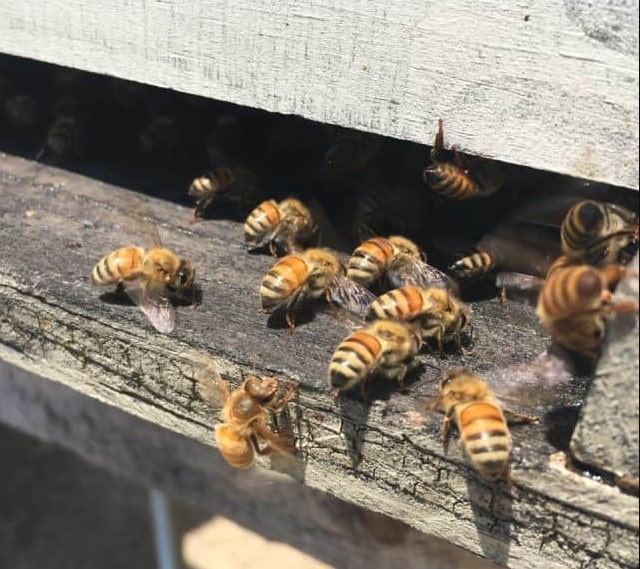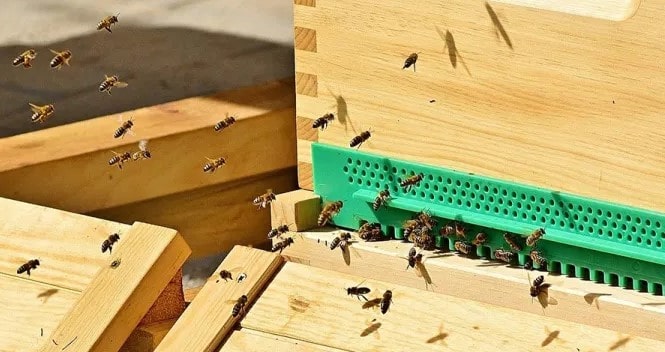Beehive entrance reducers act as a restricted for the hive’s entrance. However, there is some debate about whether an entrance reducer is beneficial or harmful to a bee colony. You may be wondering what an entrance reducer is? When you need a beehive entrance reducer? How is a beehive entrance reducer used?. In this post, we will answer these questions and help you decide whether this is the right path for you and your beehive.
What is an entrance reducer?
An entrance reducer is a thin strip installed in the entrance. It is typically made of wood, but it can also be made of metal or plastic, with a notch, or sometimes two. The main purpose of a reducer is to restrict or reduce the entrance of the beehive to a more controlled area.
It is used in the larger hive entrance to protect against pests and rodents. It also reduces the chances of attacks from stronger colonies of bees, and aids in the temperature regulation of the hive during the winter months.
Why would you need an entrance reducer?
For a variety of reasons, an entrance reducer may be beneficial to the colony and hive. A weak hive may be vulnerable to yellow jackets or honey bees looking to rob the hive of its honey. An entrance reducer makes the hive’s entrance smaller, making it easier to defend against these threats.
Another reason for using an entrance reducer is to keep the hive from becoming too cold during the winter months. The hive should be kept at 96°F for the brood to survive and thrive. Bees keep this temperature stable in a variety of ways:
- They flutter their wings to ventilate and cool the hive.
- If the hive becomes too cold, it will form clusters to generate more heat.
- Using “heater bees,” which have a higher body temperature than other types of bees.
The temperature of the parent colony can help determine what kind of bees they will develop into. From there, you will know what role they play in the hive. Keeping the hive temperature stable is even more important for the survival of a productive colony.

Read more:
When should an entrance reducer be used?
Bees will thrive on their own. However, they require a little assistance from the beekeeper at some times. The following are the two occasions when the entrance must be reduced:
-
A weak colony
A herd can dwindle for a variety of reasons. Pest infestations, attacks by other animals, and honeybee hive robbers are all possible causes.
Before attempting different solutions, it is critical to diagnose the problem. If you have determined it’s due to a pest infestation or attack, using an entrance reducer can allow bees to regroup and protect themselves from outsiders. If a flock is attacked, it will become even weaker. As a result, providing them with additional protection may save the hive.
-
Extreme cold
Temperature regulation is second nature to bees. They regulate the honeycomb’s temperature between 95 and 97 degrees Fahrenheit. However, in extremely cold weather, this task becomes more difficult. If bees can not regulate their own temperature, entrance reducers can protect them from wind, rain, snow, and cold.
Some beekeepers leave equipment that reduces their entrance year-round. Because honey bee thieves may appear in weaker hives to steal honey before they can take the honey and make one of their own. Reduced-entry devices allow bees to concentrate on feeding and raising young, cleaning the nest, and making honey rather than worrying about intruders.
Many people advise using it only when the weather is cold or when the hive shows signs of weakness, such as a decrease in number or an increase in dead bees. Bees enjoy cleanliness and will quickly remove dead bodies. If the number of dead bees inside the hive increases, it could indicate that their population is declining, and they are vulnerable to attack. At that point, installing an entrance reducer may be the best option.
Why are entrance reducers so contentious?
Can destroy bees
Bees are completely self-sufficient. A foreign object that is beyond the control of bees when brought into the hive for a long time will disrupt the habitat and prevent natural activities.
When used during the winter months, an entrance reducer can help protect the hive from wind, snow, and rain. Unfortunately, it can also prevent them from cooling down if the temperature rises during the day. If the hive becomes too warm in the winter and is unable to cool down, moisture will accumulate in the hive, leading to mold growth. The end result of the destruction is the death of the bee.
Using an entrance reducer during the winter months can help the hive maintain proper hive thermoregulation. However, beekeepers must be vigilant to ensure that the device is removed if the weather warms up.

Other alternatives
-
Small clumps of grass or sticks
Instead of using an entrance reducer, small clumps of grass or sticks can be placed in the hive’s entrance. The grass acts as a barrier against the cold, wind, snow, and rain of winter. However, it is also moveable and permeable, giving the bees more temperature control.
-
Using propolis
If necessary, bees can produce propolis to strengthen the grass and sticks. Propolis is a translucent mixture. The combination of beeswax with saliva and the addition of tree sap from other sources creates propolis.
This propolis will help bees to seal holes and gaps in the hive. Bees will often use propolis to restrict their entrance on their own, but they can get a head start if you provide grass and sticks as a starting point. Allowing the bees to have control while also providing them with the resources they may require to stay strong will aid the hive’s overall survival. This strategy can also help the hive and allow them to become more self-sufficient.
Conclusion
An entrance reducer is absolutely necessary for beekeeping. During the winter, they are a vital source of nutrition for bees. However, you should exercise caution when using them in warm weather because it can lead to mold and bacteria growth. If you do not want to use a honeycomb entrance reducer, you can try the other methods described above.
Read more:
